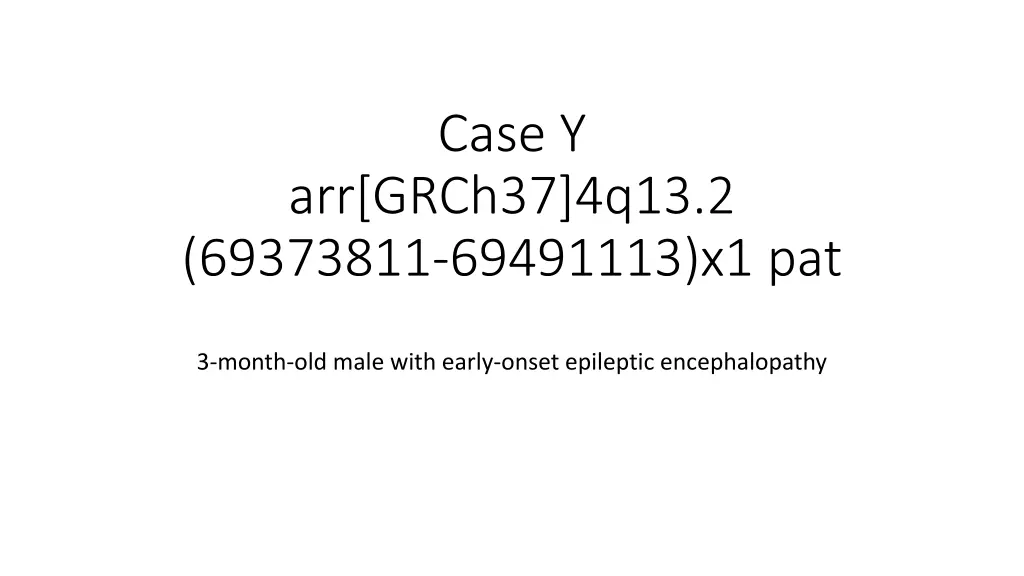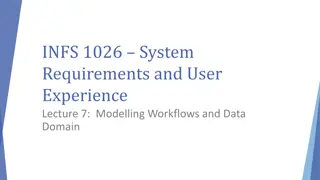
Genomic Content Evaluation for Early-Onset Epileptic Encephalopathy in Infant Male
Explore the genomic evaluation of a 3-month-old male with early-onset epileptic encephalopathy. The patient shows severe symptoms with no reported family history of seizures. The assessment focuses on protein-coding genes, overlap with established genes, gene number, and detailed genomic content including UGT2B17 involvement in steroid hormone metabolism and bone health. This detailed evaluation aids in understanding potential genetic factors contributing to the condition.
Download Presentation

Please find below an Image/Link to download the presentation.
The content on the website is provided AS IS for your information and personal use only. It may not be sold, licensed, or shared on other websites without obtaining consent from the author. If you encounter any issues during the download, it is possible that the publisher has removed the file from their server.
You are allowed to download the files provided on this website for personal or commercial use, subject to the condition that they are used lawfully. All files are the property of their respective owners.
The content on the website is provided AS IS for your information and personal use only. It may not be sold, licensed, or shared on other websites without obtaining consent from the author.
E N D
Presentation Transcript
Case Y arr[GRCh37]4q13.2 (69373811-69491113)x1 pat 3-month-old male with early-onset epileptic encephalopathy
Clinical information arr[GRCh37] 4q13.2 (69373811-69491113) x 1 pat 3-month-old male with early-onset epileptic encephalopathy Severe phenotype population datasets are expected to be depleted for these types of presentations Inherited from 40-year-old unaffected father No reported personal or family history of seizures of any type No reported personal or family history of any other neurodevelopmental disorder Use LOSS scoring metric
Section 1: Initial Assessment of Genomic Content Our case Protein-coding gene Contains at least 1 protein-coding gene (Category 1A) 0 points, continue evaluation Total: 0 points
Section 2: Overlap with Established/Predicted HI or Benign Genes/Genomic Regions No ClinGen-curated genes or genomic regions in this interval.
Section 2: Overlap with Established/Predicted HI or Benign Genes/Genomic Regions Does not meet criteria for HI predictor category (2H). Total: 0 points
Section 3: Evaluation of Gene Number There is only 1 protein-coding gene in the interval (Category 3A, 0 points). Total: 0 points
Section 4: Detailed Evaluation of Genomic Content Braces in OMIM indicate contribution to susceptibility to multifactorial disorders Current evaluation framework most appropriate for use in Mendelian conditions.
Section:4 Detailed Evaluation of Genomic Content Per OMIM: UGT2B17belongs to a family of enzymes that catalyze the transfer of glucuronic acid from uridine diphosphoglucuronic acid to a variety of substrates, including steroid hormones. Quick literature review indicates that deletions involving this gene appear to be relatively common. Deletions have been studied in relationship to: Bone mineral density (Yang et al. 2008, basis for OMIM Morbid link) Testosterone/estradiol metabolism Pharmacogenomics
Deletion variants over this region are observed commonly in the general population across numerous studies (overall, ~36% in gnomAD; higher in certain subpopulations). Apply category 4O, -1 point. Total: -1 points
Summary BENIGN With a population frequency this high (including many homozygotes), it is unlikely that this variant results in any demonstrable Mendelian phenotype. Highly unlikely to be the cause of the patient s early-onset epileptic encephalopathy. Additional testing is warranted. Could assign additional negative points in Category 5 for the variant being inherited from an unaffected father, but this is not necessary.
What if What if our observed variant was larger, and included this region in addition to other genomic material? Consider case Y2, same reason for referral (EIEE in a 3-month-old male), also paternally inherited: arr[GRCh37]4q13.2 (68230771-69566933) x 1 pat
New Case Previous Case Less Significant Overlap with Population Data Additional Genes Involved
Cannot rule out the rest of this deletion based on the population information for the previous case!
Todays Attendance URL and QR code: https://tinyurl.com/AttendanceFeb20










![Comprehensive Case Study on [Insert Case Title Here]](/thumb/159705/comprehensive-case-study-on-insert-case-title-here.jpg)











